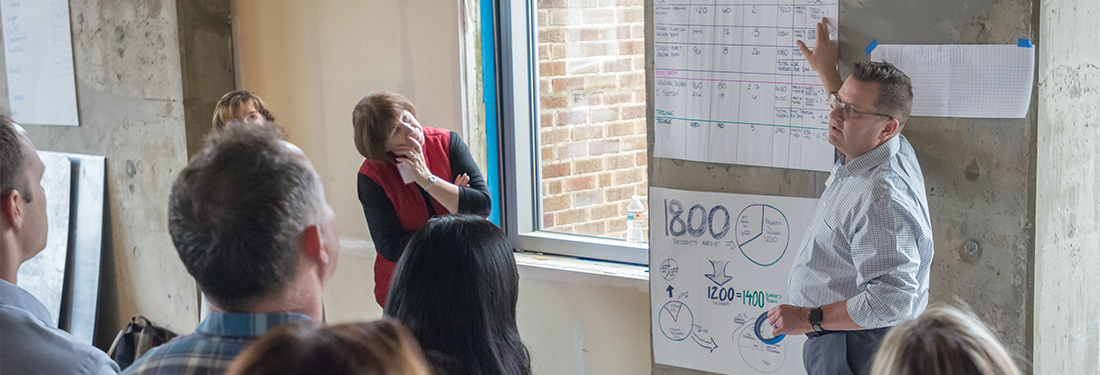How a Value Stream Can Help You Produce Higher-Quality Care, at Lower Costs, for Your Patients
What is a value stream?
A value stream is an improvement philosophy, a systemic way of thinking about the flow of delivering quality health care. Providing value to patients is the heart of a responsible health care bottom line, and at Virginia Mason our lean thinking foundation allows us to eliminate waste and improve quality — which, in turn, keeps costs down.
So what is value in health care? Value is defined as any activity or behavior that the patient is willing to pay for. Value is also about designing systems that create seamless care that supports the patient, product or service as it transforms during each step.
Value is not about delays in care — it’s not about patients waiting to see their doctors, nurses searching for supplies when floor stock runs out, or a defective medication delivery system that introduces risk and harm into the equation. A value stream mentality allows us to view care as a series of dependent, interconnected episodes and moves us ahead of traditional isolated point improvements.
In fact, value streams provide transparency that enables us to improve care across the patient experience, leverage the collective wisdom of the teams involved, and identify and solve the problems our teams deal with every day. Using lean methods and tools, our health care teams can remove the static and the noise from our processes and drill down to what really matters to a patient.
The goal is to create a process that flows smoothly, allowing the patient to get engaged in his or her care. In too many organizations, the delivery processes are chaotic and confusing — with an abundance of variation — and patients are left struggling to figure things out. When teams can work together to eliminate waste and create a smooth process, with quality and safety built in, patients can understand what is happening and can participate fully in their care.
How a value stream reveals what really matters to patients
It’s important to understand that a value stream is not about supporting the assumptions we make about patient care; it’s not meant to be used to make a declaration about care that will work forever. It’s also not a tool that supports people’s opinions and hypotheses that have no data to support them. It doesn’t justify silos of knowledge.
Mapping a value stream allows teams to get at the truth. It helps us observe our processes to discover what’s really going on in our patients’ journey. It helps us identify problems, understand workers’ perceptions of problems and then engages them to improve the process. It’s also about engaging patients and families so that we can fully understand their entire health care experience.
“Mapping a value stream allows teams to get at the truth. It helps us observe our processes to discover what’s really going on in our patients’ journey.”
– Ellen Noel
How a team can work together to produce a value stream that puts the patient first
Lean leaders participate with their teams and help them focus their efforts on real-time observations where the work occurs. Those who truly want to improve care and respect the people doing the work must spend time observing in such a way that they uncover truths about the work. Lean tools — which are quantitative, standardized and objective — help us uncover the root of the problem and shine a light on opportunities to improve.
It’s natural for team members working on improvement to feel disturbed by what they find. Leaders may ask themselves, “Why do we find it acceptable to put such great providers in such a messy system?” Other team members may feel discouraged by all the waste they find in the system and feel uncomfortable talking about it.
But good leaders know that thinking differently and voicing ideas for change are essential to make meaningful improvements. Everyone on the team is expected to participate and to respond with urgency. In fact, in a Harvard Business Review article on leadership, authors Ronald Heifetz and Donald Laurie discuss how important it is for leaders to challenge an organization’s most entrenched beliefs and help teams move toward solutions through adaptive change. This is essential for employees’ growth, an organization’s growth and — most significantly — our patients’ health.
A case study: Optimizing chronic illness management in direct primary care
At Virginia Mason, clinic nurses known as RN care managers focus their work on patients who have complex chronic illnesses. In one Rapid Process Improvement Workshop (RPIW), a team of nurses, medical assistants, physicians, pharmacists, social workers and patients worked together to define the RN care manager’s role for indirect care and direct care for patients with diabetes. When they looked at the capabilities of the different team members, they saw that patients could benefit enormously from intensely focused time with the RN care managers, who were skilled in assessing their patients’ ability for self-care, training patients on how to properly administer insulin injections, and using teach-back techniques to discuss blood sugar control, exercise, diet, sleep and all the barriers that can prevent patients from managing their disease.
The team studied opportunities to remove waste from care manager workflows with the goal of increasing their capacity so that optimal nursing care could be delivered at just the right time and in just the right dose. The team identified two key workflows needing improvement: the discharge follow-up phone call and the physician-nurse linked visit.
The team studied the linked visit, created new ideas to improve it, tested those ideas and implemented them using standard work. Today the new physician-nurse linked visit is going strong. During a 40-minute time frame, the care manager spends the first 20 minutes assessing and educating the patient. Then the physician enters the room, and the three of them build on that conversation, allowing for active patient engagement and confirmation of the care plan. The patient benefits from a comprehensive visit linking the physician and nurse into the care, and the organization benefits from a documented visit that allows the care team to bill appropriately for a comprehensive interaction. The linked visit model allows for meaningful, connected care to take place in this one appointment, where so much ground is covered and so many questions answered.
This is a great value stream because the patient is receiving high-value care by working in a deliberate way with experts to get the care needed to live a healthier life. The nurse, who has set up the chronic illness discussion, is working at the top of his or her skill level, and the physician is focused on diagnosis and the appropriate treatment.
The need to keep pursuing good value streams
At the institute, we introduce the concept of a value stream by showing a photo of a stream and explaining the importance of flow in health care. One physician attendee said, “If a stream goes too fast, it will erode the bank.” He was right. It’s essential that our value streams allow us to pace the change so that the work is not only respectful to our patients and our employees, but also sustainable as we keep finding ways to improve care.
Rapid learning is important, and so is incremental improvement. It’s always best to look beyond short-term fixes so we can achieve our long-term vision of improving patient safety, patient satisfaction, staff satisfaction and costs. Our value streams allow us to move ever closer to the possibility of zero-defect health care and a responsible bottom line.





